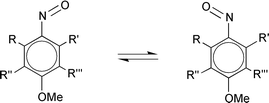Nitrosoanisoles. Sensitive indicators of dimerisation criteria for C-nitrosoarenes
Abstract
A series of mono- and di-methyl substituted p-nitrosoanisoles was synthesised either by direct nitrosation of the anisoles with NO+HSO4− or by mild ![[double bond, length as m-dash]](https://www.rsc.org/images/entities/char_e001.gif) O group in the monomers. Magnitudes of ΔG‡ were in the range 28–41 kJ mol−1 and were shown to be sensitive predictors of self-dimerisation tendencies of these compounds. This
O group in the monomers. Magnitudes of ΔG‡ were in the range 28–41 kJ mol−1 and were shown to be sensitive predictors of self-dimerisation tendencies of these compounds. This ![[double bond, length as m-dash]](https://www.rsc.org/images/entities/char_e001.gif) O group, was shown to be a reliable predictor of self-dimerisation of
O group, was shown to be a reliable predictor of self-dimerisation of ![[double bond, length as m-dash]](https://www.rsc.org/images/entities/char_e001.gif) O bond length and the wavenumber of the IR-active N
O bond length and the wavenumber of the IR-active N![[double bond, length as m-dash]](https://www.rsc.org/images/entities/char_e001.gif) O stretching mode were found to be somewhat less reliable predictors of this behaviour.
O stretching mode were found to be somewhat less reliable predictors of this behaviour.


![[s with combining breve]](https://www.rsc.org/images/entities/char_0073_0306.gif)
 Please wait while we load your content...
Please wait while we load your content...